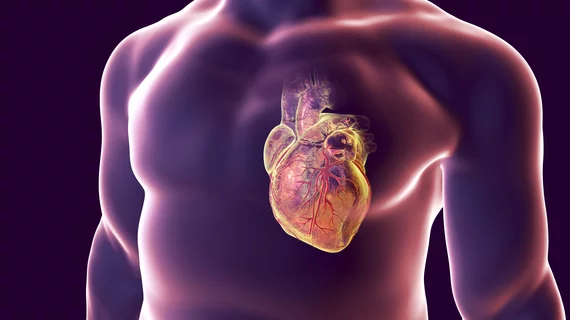Originally thought to be a benign condition, Takotsubo syndrome is associated with long-term outcomes similar to acute coronary syndrome (ACS), researchers reported in the Journal of the American College of Cardiology. And in cases where Takotsubo syndrome (TTS) is triggered by physical events, prognosis is even worse.
TTS is characterized by acute myocardial injury in which the left ventricle changes shape, enlarges and loses some of its function, often dropping ejection fraction to between 30 and 40 percent. About two-thirds of patients have identifiable triggering events, typically from a physical or emotional stressor. In fact, the condition has been colloquially called “broken-heart syndrome” because sometimes the death of a loved one can spark the incident.
For this study, lead author Jelena R. Ghadri, MD, with University Hospital Zurich, and colleagues analyzed data of 1,613 patients from the International Takotsubo Registry.
TTS was defined as “a transient wall motion abnormality in the left ventricle beyond a single epicardial coronary artery distribution” along with new electrocardiographic abnormalities or elevations in cardiac troponin. These characteristics needed to be present in the absence of myocarditis, obstructive coronary artery disease or evidence of acute plaque rupture, because those factors might otherwise explain the left ventricular wall movement, Ghadri and coauthors explained.
Some 39 percent of the patients had TTS related to physical triggers—including 6 percent from acute neurologic disorders—while 30 percent had emotional stressors and 31 percent had no identifiable trigger. Compared to those whose condition was linked to an emotional cause, people with neurologic disorders had a 5.76-fold risk of mortality at five years. Also compared to emotional triggers, physical stressors (preceding physical activities, medical conditions or procedures) were linked to a nearly four-fold risk in mortality while unidentifiable triggers were associated with double the risk of death.
Overall, long-term outcomes of TTS caused by physical triggers were worse than ACS, but when the condition was caused by emotional triggers the prognosis was better than ACS.
“TTS is much more multifaceted than suggested,” Ghadri and colleagues concluded. “The old woman with an emotional triggering event and apical ballooning, ‘the classic TTS patient,’ indeed has a good short- and long-term prognosis, whereas patients with TTS secondary to neurologic disorders and TTS secondary to physical activities, medical conditions, or procedures reveal an unfavorable outcome.
“As medicine approaches delivery of personalized medicine and our knowledge about TTS grows, it is crucial to consider the ‘individual patient’ to perhaps improve prognosis.”
The authors suggested reclassifying TTS patients based on the underlying catalyst for their events. This may allow for more accurate risk prediction both in the acute and long-term stage, they said.
Specifically, Ghadri et al. proposed the following classifications:
- Class I: Takotsubo syndrome related to emotional stress
- Class II: Takotsubo syndrome related to physical stress
- Class IIa: Takotsubo syndrome secondary to physical activities, medical conditions or procedures
- Class IIb: Takotsubo syndrome secondary to neurologic disorders
- Class III: Takotsubo syndrome without an identifiable triggering factor
The researchers noted patients with physical triggers had higher heart rates, C-reactive protein measurements and white blood cell counts.
“Thus, it is conceivable that a synergistic effect of a severe cardiac dysfunction and enhanced inflammatory response leads to a poor hemodynamic status, which in turn causes an unfavorable short-term outcome,” they wrote.
In a related editorial, two cardiologists said it was “remarkable” how far the understanding of TTS has advanced since 1990, when the condition has first described.
However, “the fundamental mechanisms by which stressful events cause acute regional myocardial injury remain incompletely resolved, representing the next generation of investigation,” wrote Scott W. Sharkey, MD, and Barry J. Maron, MD.
Based on the available clinical evidence, the editorialists agreed TTS patients with physical provocations likely require more attention during the initial hospitalization and over long-term follow-up.
“A physical TTS trigger probably carries a survival disadvantage because of a combination of the triggering illness and the TTS event itself,” they wrote. “The magnitude of the initial myocardial injury in physically triggered TTS events may have long-term yet unrecognized cardiac sequelae.”

